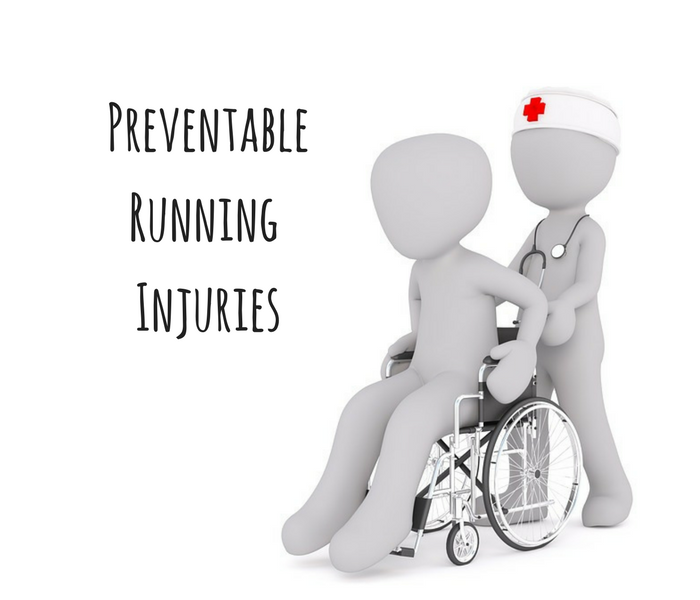3 Easily Preventable Running Injuries

Avoid These Three Common Injuries and Keep Running for Decades
Whether you run on a treadmill or in the great outdoors, in short bursts or gruelling races – awareness of potential running injuries is important.
There is plenty of information on stretching and muscle care online. This page takes a different perspective – looking at non-muscular problems. The idea is simple; highlighting these can make new runners aware of them. Hopefully this knowledge will help with both prevention, and in seeking professional help early. As always, this information is not medical advice. If you have any concerns about running injuries, then you need to consult with a pro.
Back to Basics: The Right Techniques and Warm Ups
First off you should know that the majority of injuries are going to be caused by poor technique. If you are unsure of your own form, then joining a running club or seeking the advice of a qualified personal trainer can go a long way to help. This is especially important if you are moving up in distance or intensity. While your running style might have been safe enough for the occasional 5k run – training for that marathon should trigger a consultation with an expert.
Stretching, both before and after a run, is key. Make sure you are completing a safe warm-up and warm-down every time.
Muscles are not the only part of your body that can get injured while running. Below are 3 common non-muscular running issues to watch out for.

Common Running Injuries: Plantar Fasciitis
First up is the very nasty Plantar Fasciitis. Count yourself very lucky if you don’t know what Plantar Fasciitis is, but basically it is where you generate a very nasty pain at the bottom of your foot. Known to be particularly bad in the mornings and has been described as like walking on glass.
You will develop Plantar Fasciitis if you regularly put too much load or an uneven load on the bottom of your feet. Like I said, back to basics, make sure you are running correctly and extra caution for those of you just starting out.
How do you prevent it?
Well, start by keeping your feet underneath you. New runners should be careful not take huge strides until you build up the required foot strength, so take it easy in the beginning, just run occasionally with a nice easy pace and build up your strength.
Skipping is a great way to practice your landing technique and it doubles up as an awesome way to warm up your entire body and build your foot strength. You should also make sure that you use quality running shoes. Using ‘fashion’ trainers not designed for running can lead to problems in several ways.
Achilles Tendinitis
If you develop Achilles Tendinitis then you will feel a sharp hot pain at the back of your heel. It is also very uncomfortable when flexing your feet.
Think of your Achilles as your suspension, they are the first point of call to absorb the impact before your body and more importantly your joints take on the rest of the load.
Again it is more often than not poor technique that results in this nasty injury. Excessive push off and not letting your heels properly come down to the ground with each step do the damage. I know what it’s like when you are running, you block everything out and just get zoned in but it is important to be aware of your technique.
There are a couple of other things you can do to keep Achilles Tendinitis at bay. Firstly you should make sure you stretch and warm up before every run. Think back to the last point and try incorporate some skipping into your warm up. Secondly footwear. Again, wearing the correct footwear, stuff that fits your properly and is designed for running will aid your technique. This doesn’t mean you need the most expensive pair, just something designed for running that fits well will do fine.

Runner’s Knee
Runners knee or patellofemoral knee pain as the docs all it is last on the list of common injuries that can be prevented. Moderate pain behind your kneecap or just underneath it is a sign of runner’s knee. It will often stiffen up once rested and may cause difficulty and discomfort when walking.
Most likely cause – overstriding… I’ll say it again, when running you are looking to land with our feet underneath your body. Landing with knees bent and your foot too far out in front of you is not what knees were designed for.
Decent footwear, knee supports and the occasional anti-inflammatory may help, but to be honest it is more about correcting that movement in the first place.
Running Injuries: Failing to Prepare is Preparing to Fail
I hope you can now see that preventing injury when running is all about having good technique and preparation. As with everything eating healthy and staying hydrated means your body can take more strain more often. More specifically warming up, running correctly and getting enough rest is a must if you want to keep running for years to come.
More Popular Guides:


